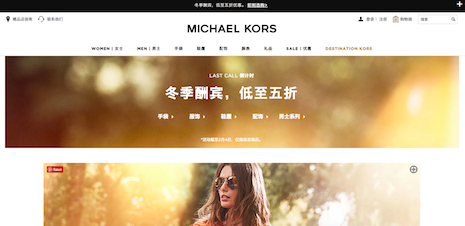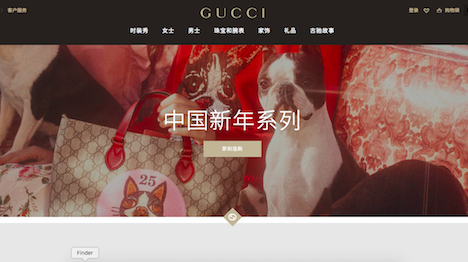Digital campaigns in China are juggernauts for driving brand sales due to the country’s technological advancements, which have resulted in it being the largest ecommerce market worldwide.
In China, brands are able to create a two-way relationship with consumers as 62 percent communicate with brands through social media and by the year 2028, it is likely that 50 percent of all purchases will be made online, according to a report from Fashionbi. However, brand strategies there may be lacking variation, with many marketers using the same campaign tropes on social media.
“There is significant similarity in the brands' strategies, e.g. different brands collaborate the same influencers, for Saint Valentine's Day, the brands launch special capsule collections of the handbags in the same red or pink colors, or for Spring Festival the companies release special products in red colors,” said Yana Bushmeleva, chief operating officer at Fashionbi, Milan.
Commerce in China
The United States’ massive retail holiday Black Friday is paralleled by Singles’ Day in China. However, Singles’ Day is exclusive to ecommerce, which exhibits China’s advancement with consumer adoption to online purchasing.
Since 2013, Single’s Day has surpassed Black Friday and Cyber Monday in online sales combined. In 2017, the Chinese holiday saw $25 billion in online sales while Black Friday and Cyber Monday saw less than $15 billion online, according to the Fashionbi Ecommerce in China report.
Brands in China must be present and active on social media, with the country being the second-largest region in the world for social usage.

WeChat Pay will soon be usable with a variety of luxury brands in North America. Image credit: WeChat
Consumer electronics, home appliances and beauty and personal care will become the largest segments in terms of online shopping by 2020. Consumer electronics and home appliances online sales will account for 55 percent, a jump from 27 percent today.
The beauty sector will see a rise 27 percent in two years, to 50 percent.
China has a total of 470 million shoppers who spend most of their time on Tmall, Taobao and JD.com. Tmall and Taobao make up 52.3 percent of the ecommerce market.
Brand initiatives
Luxury manufacturers who enter the Chinese segment need to have a presence online. For instance, Burberry launched a WeChat account and a China-specific mobile and desktop Web site, boosting its sales in the market by 70 percent.
In 2016, Gucci also saw significant growth, in the double-digits, by placing digital as the center of its strategy. Michael Kors also saw its sales double in Asia after launching new commerce initiatives and also opening more than 100 new stores.

Michael Kors' Chinese Web Site.
U.S. fashion label Marc Jacobs also opened its first Chinese flagship store on Vip.com’s luxury channel.
Marc Jacobs’ new online store opens the brand up to VIP’s 300 million members. With existing infrastructures and audiences, China’s ecommerce giants have become appealing partners for luxury brands looking to sell online in the market for the first time (see more).
Also, the Council of Fashion Designers of America (CFDA) is leveraging New York Fashion Week: Men’s in February as a platform to introduce Chinese designers to international markets.
Together with Shanghai’s Suntchi Brand & Technology Co., and in association with Alibaba-owned Tmall, the CFDA will organize the first “Tmall China Day” during the week-long schedule of collection presentations. Part of the CFDA’s five-year partnership with Suntchi, the effort is designed to build a connection between the Chinese and American fashion communities (see more).
“While working on the report we were checking the PR activities in China and the financial results of the company in Asian region, what we have learned that those brands which invested in digital activities, opening of the online stores, or launch of the Tmall store, WeChat campaigns of online promotion with local influencers, witnessed also improvement in the brand's positioning and sales results,” Fashionbi’s Ms. Bushmeleva said.
“China ranks second in terms of social media usage," she said. "Sixty-two percent of the consumers in China use social media frequently to interact with the brands.
“Overall, the Chinese customers are very tech savvy and according to the predictions, one-third of the fashion purchases will be generated online by 2020."
{"ct":"WdDHep9+LpHrhn5jDCloOVoM0jA5vHflUf2hsH\/r4RFU0i4E2bAs449M1Z\/NY9P2TJSVXkNZnNkJwu+GF+RQUaRgtjlp2hlWs8IZqZbxF+QH4aWo7yPi\/pT2ZSm1z41UowqhFyHom5KvvRdTl+U7eLe\/g5kzNkpqFW8Oisq0m7v5IlJBltcyCz5UD0InqaCM\/y6DTddHZI1u21CsMVN6TOm5PtjFRHnCvWT9oPmgpMwEs\/KaoAXuEDrY6Z2l5vsmqFzGu3MPUFomK\/mQ8SPtNogCNFFSeOuvTmS3lLvI\/4Jn+2ZiY56V8rN2M6UuMfOjbj7rzZv3Nzq2M\/mfCuYcoI1iz2T1rlrQ3tUf8rkfW6PLVTfgL+r+896f4d7tBrLAXoy80xstVbU9+mtl2Z7uiXmZQdF5j2hFYZ\/jxIhp1kochJIB\/\/hI0avUMYm7gLOsQymP4sIJh62IM1ZHGF2qaGX3ZA620t2Pv83jNswR15Q+W\/mHD0F51d3+C+e3IhNAMW7T5MMt6qfnrjZhZ+W1o9VumO7TqWBJHEDgrepd4pN5OnkeCAtgJ39YB5SctPiKrIyrLKDchHNM1wDNNvR12D6fSL\/qzlB4ZhxbmVpznrZRdn2H3mJiNgOgkmMPStNbGL02BmAYIyNJqvmPs79HtAvmLs\/+zh\/iF8JabLw8CcSpF+fg+Z7exbFZIrlNrlE7GuLerBV\/vY+KGCwCCBDnwcM44PHcHDwOOpAB6N\/RLKL80e6QvYm8IiQmIQWLPndNUppmoWYRVEaxF3YoY5YCeYdtq+taLLbrzBmd0SPDyfb8vEW7ufBwC+jkx36Q4c8NYvg5PSu1G9RlQZSrRlB6hG45MK8XaIRL+MVcWA2Jy9YfMqh6UBSVp5laRP3zou4nv+LkasgIKDIgU+NZkCphtyALVVzb+nnMkH0j4\/D0ec0WfOA7xKlphNkm+Pxdq74OrJxyqaS\/KkWou3n3M9URKx+chFhLbv2ktVpIDRkzQDSanRVOuCf5rX9bfjm\/CGNgQ\/2vwe9J84qIObYGlPU\/w6ColxsIyNQZrDhBol32BlLevrgs6+LImp224Bvl8Z9JVo0NSFRkLzCB3iUQmBV35eSdc8XXjbxDvMCIVqtci\/iungBAS1VrLxBcU\/VxtFhHpFcmP0kYF3DC+W16x+NtxqtX3WOuEhU0jmGFlMi7KBvoT9CjENm2ZRB9xcZyuIEAF8uoFwiJlBfEErZ7+YAO7qLWPHxAfN7sbH4hkKWrKm+7zGKXl7NFAf1I\/Mnn7BXPl9\/zklRlWbsmN0Cc9xd3gvJXTkUkJl5Q1PAEoP6g30nEl4HAvwUjGtIu\/FNZQ15sgBbK\/zIUWfNEy78SjoeO2uz06WwXwzCxRjZ9WJ1h4g6ELPPdrYrLMkdiqmSdBvpJ\/kdhqz\/C\/ZPgJFyYVWbwP3JE+pwnmQmTTTH45pBZmUqRIgHGVJWim\/Ttr020\/PUQBzYrGfuNSg5MmiDCunpAF7NeP0K12txe4b5qgEXjye6jC+2kCU7\/14C6Q+YHMA\/JpH+P1VyODwqyJC\/To86T97wVYK+zBRwyOBwD4Ue9DXE\/NYeNDIkZdzsz43Fa\/zWbjQMEqOcoRzyalJ6hJkj3+HSAMYKTF7lp28Hz7Z9\/XNrgp0rN6Xwa9MagEmUJ1K8Oc9WT0yWoMtIvBd\/ZsfNN7pBal\/e7Xx05wjzmOy1ffeAi7Sr6238sH1RaBIRffQPniAAB6gvoTPQRM0+AXlkKGRCzYA4zWg\/HIjbv6lf913IVnD2XI3ezw5+pkixFEPeZRjaX6W2xaJYz2roIVMqSD+rMUJSgpnPgySh88WlZ1im+PjW+mYXbA\/LQ+ggx928WWhwHqK+JJIGB5t6Y8xQ14HigTOcu89E0GNIwoyD305J4a8RZ5BzCxAgBLTWDQHF8PwClwVTIEg38GOW2S45RoTpJ7p9RT73TpeAFwRge2sw3lEQmRrQYDXE96pXY\/vnUhU9Xdilc\/3g38V5mP6XQDhQl1+KZz32pNGEl9xwnUC7+hAUxG0vrbiEOXlCUJHu3NyezILrM+5ESi9jq99WmeCcVvFVeuc7faAhdtsKERA6tStwpGYvZp+8GiwAuaIsnrh+j3xeX6O3ThHB5atsAiAAewIKao6bEugQsYhCmaUHpDlrh4iKmjhY6OX2eLabCLLsdE2kpjiB+UK6PLUs4CO0tv6wU0gFxPdV\/iINkrOv7tUR2DRWBfCnkQwTls2SclmqvIC8rICBpCHlyM3S0NzdT6+U134W26oBzWRhdvixxJru+L+GEb0ODbrCSodkycQKUbEKpMo9Mq3bIqKMCM3YdaodQ5Mg+tQdkKl9QDoeP9CWPx+BCWp2XvMbOXFIggiNwAtkApvw7dq4FR4S\/HQd7gZQc8osrTEC5EYvndMngwgY1hVd0597ivR9Wu+MLXBfGKICzy86ciiVFDuacif1vytPbVAGQyYHjk4H9hZMyjuEA1mP8W53y4lRY88HrdjWJnDZs9l4NkejcBkYfABeld2loVLhjUjW2rqWhXgl4MS9qtKJOsbAer7JwnwjN1sEafvozqwOgzcoqeOLj0cJxuqZCYcFc0M83PozOwdADI5ibD4ZqmmpbLIVONKifmyiYXWkPLjTUInArR8sOo7K85RaI1NSZToD068G4+siNEtVA86OWhnqX88qvxKy2pA2984g\/ypfIOVfs2FBibqcnF+jzlMg9i5lPWR9\/keONdzfRUDX8wtaUfnlXXA2mrs0XF0mV1ojV1GmBeHiBrU+aVCHIFe6Pzs33AAvLGnH\/2u4bu5oBcs+I6DJPgNaVjzdBDcdg6j+v+HlPdp3z+beeDS3owjqWBOLVXkozv638OlJrES201WZZRcMF5Ijuthl7ZCj51rhNcu0KlY0x8p3PXcEsLmKeK\/ftG\/qvnFqOgzh56dzkSdM7+m6nyo+ecfj+eD2rHvZ+d+QOfKanSHWbuVLSQCWxCZ0JLwVxjTR97VVu4XmdMdIoWozyXJydgDdzdK6DA0HyyBWCW4LJkLjttDD0X96DZmTZnsqg9OiUjjdnnfCnnz+XccQiTB+rEQuuvuF9Ys44JZJ1HpLQFN0UliVwGSS9C7c2seNkMcTSeeORyCDKjbbItVdjL8TKjdoXiRAnf81LChdbcfzHSwIM1uGvJFLEHstWMXdhfG50Dmu34sD6iwi+1VV0rvVMjGRdfRq6qEC1rGdprvGTm1QxEkJPHm65VYbnH2v5lT2HMhRmly+DRx\/+k\/dXrsSOOiA3yYAAt06hwsqBIg0Qr2xxKbfsIDa2surmGneYs\/1MCqLqemP9G+5wRcVmnH4lQZY8l54iMZ4KHSs69IeFfNJEkEoZbvHKPtdaKDE8yw\/h4cF8xciaM7pCwjwm6RnGLXj+8gco+IBAj2ak85Mlmbs9Upg6xf\/TUbrtFSjssjWoOI7dnzumhLroyBWXtkYLZUwl6xIMwDZaAJMsFFCuM\/unmBiVITwB03juIz\/4txL4F1Q9xuWXgoOtaxTQjxayEer9SuNNK3axyFzfllBSQEARqcKN9sRTQJfQw\/OIb8Dw11UATyQxMXKJ5b0jtxatJ4QKxFLILiU2FmRL9vc7a9dMZvYvtG47TRl0mCqS+j6xIVYTi4W91Zud8avfPdzxbZUxrG+zsZN\/GYl452DYI88kS7xlirnEvW\/wJA7IOBsPFVH7MY99wBH\/8PwD9\/Stj3zsd8N8oZoQqGbqemco7YTK5d+YtCNgDRRQBVEzOKTrvvkQzmCYWNsi2cHNPywgvajJ2WkBY\/qMcNvC9z4VRu8kHMXwxhBBwd3dXeynoLNnfG0EVOWItvt5jvsCKCYu8NjzwY3p8yR+Vw\/kNGgNM6vRaDRkZwYafm0sdcLuOAEyDgZYWngBeoUxkYENjFYjBjID87NEWOg4INe4L1zvVFQwUWykH1aDxk0ufN9jKB0jVaANPdwvsHOmOpp6meXWbiBjDko7hx7l\/lhjxzE\/YUnftwKXnL+kfbggiHNhN807MvYIDWNZ\/sbdXELrwzWM\/dCTYjqMoEL35uDKh68xcNaA2lYtylTBku430JMqPzLcDS1P9iSO+pLVabal9H4iSAm80YdoYFCqMWDcK1crWpsqE7\/\/7YuXKHKjODf15niXVJqOxiOlSGWoXiMl8L8XRRbuIaGSxJHuSn3yEcY2uI43d9ZUkF6rzrSnV43RZnbUW6V0Tvke+kCq273JfSSRz894kaz7uPqViI5i+JkL6jD8d999P6yparoqW2Chbq2hScXnlI4TiFxcTpkP\/g1RJA9jWVtL6342+oufvUcOSxspwxpwHjUycATCpopOe9rVlbO5g8oy6z2oAcEC234aBTqrRFiNwdnb4hX7uNkn1VFmpsVhvKqk6rfx7SWIakPm\/Kp\/2Rip74UBrz8r\/USz\/z91VuZhaOPx4KsA3V84u8bGldoY11WFpWHuuGgjc589cf8v2Khs5xP5F2gxRXo51dvoBWV2shA8Qf1aXFTA7m6EHmjmTcIpdj17UuaIJY01wroo1FE2H6\/b58czeRUuBjNxPJ5R5gg\/QfRu8WUZBsngvkt5idyifxn7iBFSK1Cgwvjt+ImpVYys1ldSun7n08NaLuFuLoODKIT8epmJvHDCxNl4aTZXNIiVUkt3MaYdGXl924sF3o94XGHVeNMVlHsITMPa2clijuqzzIyWh6pg3hDqaNyMkiOWs+Ywv3Ff++8GlzbXvcAiUKgSxF+f1G9GaEKsWdD45XNgWSIm6OQyLjKhgQ1M53FRXtc2YFFafO0YXfmmDhdV4hRd1xRfDjk2Vu6BQl5fGx7tlCXVDDBYuzrzNLuQk6u29jAgLHuMuvp965bcboi\/ihLPCvwcs0xABLPEvi\/asm7ytN3qa09lGwOanI1uyGPjgEZLAWD38p7abCMZK1+V82HYt\/FsSxcQQhI3kDWTbiXc2Ahso8mU2WUuIc6McCTrh3G\/+GsOw2D0VDI7zmMl074kv2hO15uEC0Bvt2xJlXAMp9E6Rt0XffC76qfKY\/EMp0W8KuBQLGThN+9TVe+5GCma9LwUMJ8f5EAu1TJBUGw4CoqOAGzRJqS2ErQ6Wp+zlflKbsPJAHax89v3w4bLMf3oFLF+2brx7vDpuJyMp3IaBwuxOFYXLJtT7waS66k5sPwcAXrOffqcGAKvr0RHSuOvBiyo9A0Qyetr+qiMwObLtSJtlbY63rT1bNsP+4FciZ0Eb\/XkZpcqPk50bj6Qbw4M7Fz8mkBV8kGerSQz+HPbl3M3YOPHIHVuyrNPfDhOJojpH570l+6G96IMM8Mp\/ByC+h0+5nWmfR1PiafBEk270kWQpknfvm69tcLxtKxNjHmoeI3XoBqvODxVoHrz1rlJAMXtZaijqmZlOyAmNr0ckszPsUF7wHEaUqTVfwQ1OEiOudqcIu8LVy+4dRXLGdmF+AD+0G7J0UoxttAxCquoNqNe9JgVxTx1vq7KpxQ4y8Aftuwi6FMb9Hu5oOuDBsi\/6gXjFErq7Ra2eyWcwot6mmBNJfzZDQXyG8YdTI9fRkqwh8dy6dSyhNIUR5dN5nltweERow3Zw5h1B4zLnOp0Y+8Cv69Es61442LaCEagyaBq8Nqz46GcO8SczjU6XBXll14jPLuEC\/x2wx2K8cvJYzlklOZUStvcioWaaqeJtoT36+cUmz9Qp88gLYkQ3Uz6NxWS9Oq5B0OwZ6yyQeoArCttvWPVxfPaTQRJAOUgrGtH2xMo66g6LXwt2Wo\/QbHEjfJtzCmh6\/iRjKim1B+856mtBkcIeH9dcXNk4GJQXJlW+zCRZo\/IKw+aIsa16lUYMCxquKn9KocCSM5NS59IG29abUzMPkSUtD41WLeldDidLV0yZJCAOLSmUQfGIMdq0oTkZOPWPbQNa9+DFa6EbWODtlcRa6bZmtDig6wN5yoEncruTWepcc8yZzCA+2eubC6lyk95ptuWuj\/yaHnFDNw0BLfFRQ8jfv5GAUYz1UshBADtUdvTac69UrcRFbGGqTMSnV1u1r2VK15oINc4gsaRGP+PC1BAAhqaFTXv1iwb5s2Jm+5wEuSMF\/s9hPeVvoMWFgOJPtuWYMxXsGopGFI9Cw9GFrIt02p\/CQiaZoUyItxPe1PQf5NTJ+x6ygTddS5o0SuVDfLCSssww3Jt4vqK\/jP9+wPDLUJgWJgHKHjx4\/SYxEaHvmC\/2+j\/djDLWut8c5BYSkNv\/SKoHi9sTEupvrQyxJUD8mo+eGOPT50EOedR4iglcBEg+m2iVfLjvTW3hEHC47+J60thMSVFqtU\/Y4a+XXSUn6MWoyH0A7HYmjiE5Ot5hK+cmSpyzyKBkCquH4iSQNKT7b0Xn3LGT5KJLOuUhlOanMn6JZ0zip9EpFvc27oWsAr1V+IccKtXqJwPcnPDuvf2NjmdkogG1ZKrNd8tEv4EOvdkcabTDkeb\/jotCyyLEQfYwW6BUUkH3kXPSgq\/tWOWopE2pITQ40\/2wc6rYTfy7\/9M5etJwZ2iMR42nvcAg5REsu0xzfqWNnWHBScXsD70EhaFFMLIi9rU6Issz0mo21tze1JO3qsDKg2VPANEoWlDJInrzKY9I43i\/LA3\/85waKrl5NEGGTVx03V1nmEpOwVGJQL4cwlHh3QHzP3F+IotAWOSgYgMHtYibqsX8lay+V+7I6zR0rV33EDTtVKZm2SQvNIztIepUpktGeGY5Z+FnxuYcZFw75EAz4T19N\/3AGGyXgJgQ\/iNHNQJDZYWO\/Ur\/sC5BWadGsWArmC9lviPWZpLPlqAgws9EWYUQ3qyZv8OQrB1N2Q9uWz\/OhLvG\/rOC18sV6cgbUywqD4z2BPHFuzejkZJU4EEw74ZHryvVuMu2NvBqA+2bBWQkuA8ksesvazjmBUH\/LWuC1lN8MlgljFPykQnYzBVe8musYmxW5nRgqHi2Y\/pQL1jBHfsgAd6xKGKECdeHtq55yaGZZdsblq0aYf93xgvUJNoh0bHcMQ5u+27MdexAbJgJrPZRnW4MJc9PwWjzymwL\/mBBl21ieuclV3pvb1NfksIVtp1Oz4FhffV9EsawC12NPhJDrCP5XVzhweXguwRLcCpnsXnKtVeaduss9iZkp9tUoNb9c6f1qrfzhAueALDpoxJQFygPKFjY4KsH\/\/Kj2E1BL5t+4Rs1h1go5LoPACcx5TFJa9STOiCQ5Be6alOSWT+vcbMG4K6TTiYnJzApD4Kd8qPvZCLIFEvm2TwGKKTI\/VgJYnA61kVxk27m0qne9\/tuKnBBHmJHfBeeTQ0opvnKiUJlFUHaE5ny3t0Z7ng5D51bMdY41Q8TzhLrto1UKxwCoBZlTW2MP2vivCVbdcnrG46CvG01zFK+8IBRNRfKI0Ncp7jv5l5pbcCexHzLA2YsfIUfytHB2WiQFniHIS1Vzj8g2GL\/84FJZHPCqBqVLZxlaIwQo9qUpweKPi0R\/6s1dLJVYcQoatubY27rOpjF4PDFhL1xt+elbKLO61uwcrUWqXORxwgCDpw3bzC5qS8RNlfKOfKW\/W23WCZv2CLvApATn+aUDJt1QXSU7uFiEv6JBpHwHjJfCweLk9LbzqRH4ch4QjRsAPNpJIqLcMw3jc2BxdsxfPJGx5NKupD9mzgHh+6dAzbwRDchRixsobYPVtzKmI1\/Vwln0TSEO7cgrmKg58I6OcPbIFcTLpiP1puhc6HWJNY3IdDMk5sy3HwtWafY0dJu56X4u3oycy2XstGcsqWyp9BqUpp+4SIP4jQODbXcB\/ShW+uc3tDkr7\/7koEFm4pajl50kUD9swH\/zNBmQxA2+OIdsW59PL5Vbe1MW\/YBIUG2rPIXzjTUWRVJ1MpQTE5tJ1OYLSjrZGjc6DlyRDBK0xUkxYwyYwzGCIu49H3XyvN3F\/13VbowKb8+dyUuS8niNsXLYKXpRc8bGcyLScTZ2JnWWAf","iv":"00374afbd74f9a7b1ce1aaf8539a565f","s":"4fa9e849e8805bca"}

 Gucci's Web site in China, as digital takes over in the country. Image credit: Gucci
Gucci's Web site in China, as digital takes over in the country. Image credit: Gucci